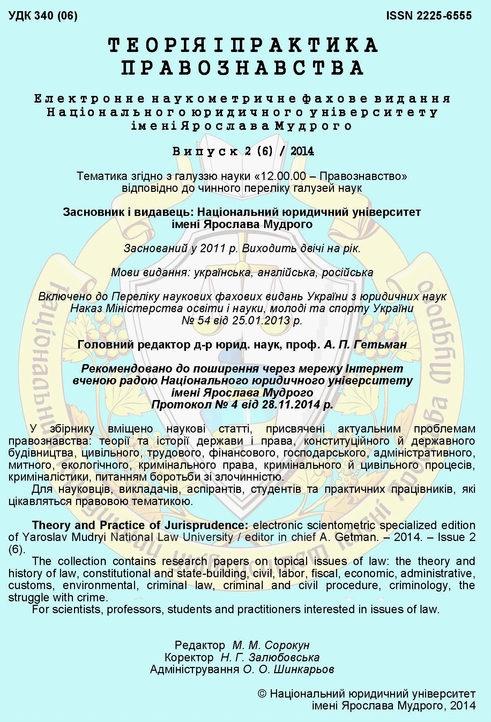The modern issues of legal regulation of use of lands of the industry
DOI:
https://doi.org/10.21564/2225-6555.2014.2.63333Keywords:
industrial land, land reform, health, useAbstract
Problem setting. Pursuant to an item 19 the Landed code of Ukraine lands of industry, transport, connection, energy, defensive and other setting make the independent category of lands. Their use established an order a law. Will mark that lands of industry are the separate type of lands in composition the afore-mentioned category of lands. The row of laws of Ukraine, which regulate legal relationships from the use of lands of this category, is accepted for today. However, special Law “About lands of industry” it is not accepted until now. In addition, in current legislation the unique requirements of ecological safety absent in relation to the use of lands of industry. At the same time lands of industry are marked more frequent all test the negative influencing comparatively with other types of lands. Recent research and publications analysis. The problem of the use and guard of lands of industry was examined in works of such research workers, as N. V. Barbashova, M.M. Bakhurinska, R.D. Bogolepov, M.I. Krasnov, О.S. Trifonov and other. However much their most labours touch illumination only of its separate aspects; and a complex analysis does not exist actually. Paper objective. Purpose of this publication is the study of package of questions of the legal adjusting of exploitation of lands of industry is deep. Metodological base of this research is formed by dialectical cognitive approach and a system of general scientific and special legal techniques. Paper main body. As a rule, on lands of industry the special unagricultural activity is carried out by the proper enterprises, establishments and organizations, and
also by citizens which also can come forward the subjects of such activity, if carry out the use of this category of lands set a law. It is expedient to underline that the specific of exploitation of lands of industry is predefined both the features of functioning of the objects setting of which is maintenance of unagricultural necessities located on them and specific status of subjects which they are given to. Foundation for differentiating of lands of industry after the levels of public ownness is a level of public ownness of property, located on such lot lands, level of public organ of power, which made a decision in relation to creation of the proper enterprise on such lot lands, and level of public ownness of property on such lot lands to his privatization, public value of bowels of the lands, located under the surface of these lot lands. Analysis of maintenance of item 92 allows to come the Landed code to the conclusion, that state and communal enterprises, and also those which are in ownness of public organizations of invalids of Ukraine utillize such lot lands on a right for permanent land-tenure, other subjects – on the terms of lease. Enterprises of atomic industry (in the that number of booty and enriching of ore, regeneration of the worked nuclear fuel, storage and utilization of radio-active wastes) are objects with the promoted ecological danger. Alienation of certain industrial object is carried out together with lot land which he is placed on, except for such cases: (а) if part of building or building can not be selected in nature together with part of lot land and (б) if building or building are on lot land, withdrawn from an appeal. It costs to mark that part of lands of industry is settled to the appeal, part, limited in circulation, part, withdrawn from an appeal. Conclusions of the research. Taking into account the having a special purpose setting of lands of industry, will offer determination of their use, which consists in a domain and using lot lands on a right for the permanent use and lease, and order by them on a right for a public, communal and private domain by enterprises, establishments, organizations and citizens as by the subjects of entrepreneurial activity for providing of their activity and (or) exploitation of objects of industry, that
for placing and exploitation of basic, subsidiary, auxiliary buildings and buildings of mining, transport and other enterprises, their access roads, engineerings networks, administratively domestic buildings (that objects of engineering and transport infrastructure), other buildings which provide activity of enterprises of the proper industry. There was an urgent necessity to select the noted lands in an independent category with the special legal mode in relation to their use.
References
Барбашова Н. В. Правове забезпечення екологічної безпеки в процесі здійснення
господарської діяльності : автореф. дис. … канд. юрид. наук : 12.00.06 / Н. В. Барбашова. –
К., 2002. – 18 с.
Бахуринська М. М. Правові засади концесії земельної ділянки за законодавством
України : моногр. / М. М. Бахуринська. – К. : Знання, 2010. – 230 с.
Башмаков Г. С. Современные проблемы нового земельного законодательства /
Г. С. Башмаков, З. С. Беляева, И. А. Иконицкая // Государство и право. – 1995. – № 8. –
С. 39–44.
Боголепов Р. Д. Правовой режим земель промышленного и транспортного
назначения : автореф. … канд. юрид. наук: 12.00.06 / Р. Д. Боголепов. – М., 1964. – 15 с.
Відом. Верхов. Ради України.
Краснов Н. И. Правовой режим земель специального назначения : моногр. /
Н. И. Краснов. – М. : Юрид. лит., 1961. – 215 с.
Крассов О. И. Понятие и содержание правового режима земель / О. И. Крассов //
Экологическое право. – 2003. – № 1. – С. 10–15.
Трифонов А. С. Правовой режим земель промышленности : моногр. /
А. С. Трифонов. – М. : Волтерс Клувер, 2007. – 168 с.
Downloads
How to Cite
Issue
Section
License
Copyright (c) 2016 Теорія і практика правознавства

This work is licensed under a Creative Commons Attribution 4.0 International License.




